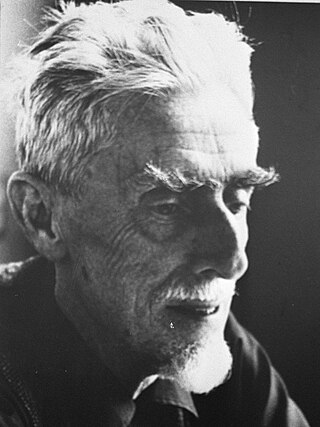
Maurits Cornelis Escher was a Dutch graphic artist who made woodcuts, lithographs, and mezzotints, many of which were inspired by mathematics. Despite wide popular interest, for most of his life Escher was neglected in the art world, even in his native Netherlands. He was 70 before a retrospective exhibition was held. In the late twentieth century, he became more widely appreciated, and in the twenty-first century he has been celebrated in exhibitions around the world.
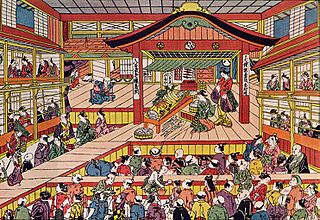
Ukiyo-e is a genre of Japanese art that flourished from the 17th through 19th centuries. Its artists produced woodblock prints and paintings of such subjects as female beauties; kabuki actors and sumo wrestlers; scenes from history and folk tales; travel scenes and landscapes; flora and fauna; and erotica. The term ukiyo-e translates as 'picture[s] of the floating world'.

Woodcut is a relief printing technique in printmaking. An artist carves an image into the surface of a block of wood—typically with gouges—leaving the printing parts level with the surface while removing the non-printing parts. Areas that the artist cuts away carry no ink, while characters or images at surface level carry the ink to produce the print. The block is cut along the wood grain. The surface is covered with ink by rolling over the surface with an ink-covered roller (brayer), leaving ink upon the flat surface but not in the non-printing areas.

Art forgery is the creation and sale of works of art which are falsely credited to other, usually more famous artists. Art forgery can be extremely lucrative, but modern dating and analysis techniques have made the identification of forged artwork much simpler.
John Myatt,, is a British artist convicted of art forgery who, with John Drewe, perpetrated what has been described as "the biggest art fraud of the 20th century". After his conviction, Myatt was able to continue profiting from his forgery career through his creation of "genuine fakes".

Shikō Munakata was a woodblock printmaker active in Shōwa period Japan. He is associated with the sōsaku-hanga movement and the mingei movement. Munakata was awarded the "Prize of Excellence" at the Second International Print Exhibition in Lugano, Switzerland in 1952, and first prize at the São Paulo Bienal Exhibition in Brazil in 1955, followed by Grand Prix at the Venice Biennale in 1956, and the Order of Culture, the highest honor in the arts by the Japanese government in 1970.

Toyohara Kunichika was a Japanese woodblock print artist. Talented as a child, at about thirteen he became a student of Tokyo's then-leading print maker, Utagawa Kunisada. His deep appreciation and knowledge of kabuki drama led to his production primarily of yakusha-e, which are woodblock prints of kabuki actors and scenes from popular plays of the time.
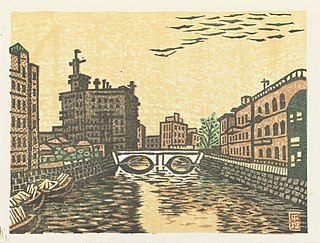
Un'ichi Hiratsuka, born in Matsue, Shimane, was a Japanese woodblock printmaker. He was one of the prominent leaders of the sōsaku hanga movement in 20th century Japan.
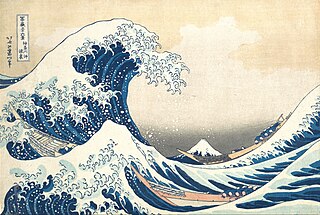
The Great Wave off Kanagawa is a woodblock print by Japanese ukiyo-e artist Hokusai, created in late 1831 during the Edo period of Japanese history. The print depicts three boats moving through a storm-tossed sea, with a large, cresting wave forming a spiral in the centre and Mount Fuji visible in the background.

Surimono (摺物) are a genre of Japanese woodblock print. They were privately commissioned for special occasions such as the New Year. Surimono literally means "printed thing". Being produced in small numbers for a mostly educated audience of literati, surimono were often more experimental in subject matter and treatment, and extravagant in printing technique, than commercial prints. They were most popular from the 1790s to the 1830s, and many leading artists produced them. One of the most famous woodblock artists who got his start from producing surimono was Suzuki Harunobu, credited with being the genius behind the later introduction of Nishiki-e.

Frank Morley Fletcher (1866–1949), often referred to as F. Morley Fletcher, was an English painter and printmaker known primarily for his role in introducing Japanese colored woodcut printing as an important genre in Western art.
Yokohama-e are Japanese woodblock prints depicting non-East Asian foreigners and scenes in the port city of Yokohama.

William Seltzer Rice was an American woodblock print artist, art educator and author, associated with the Arts and Crafts movement in Northern California.

The illustration of manuscript books was well established in ancient times, and the tradition of the illuminated manuscript thrived in the West until the invention of printing. Other parts of the world had comparable traditions, such as the Persian miniature. Modern book illustration comes from the 15th-century woodcut illustrations that were fairly rapidly included in early printed books, and later block books. Other techniques such as engraving, etching, lithography and various kinds of colour printing were to expand the possibilities and were exploited by such masters as Daumier, Doré or Gavarni.

Blanche Lazzell was an American painter, printmaker and designer. Known especially for her white-line woodcuts, she was an early modernist American artist, bringing elements of Cubism and abstraction into her art.
Wolfgang Beltracchi is a German former art forger and visual artist who has admitted to forging hundreds of paintings in an international art scam netting millions of euros. Beltracchi, together with his wife Helene, sold forgeries of alleged works by famous artists, including Max Ernst, Heinrich Campendonk, Fernand Léger, and Kees van Dongen. Though he was found guilty for forging 14 works of art that sold for a combined $45m (£28.6m), he claims to have faked "about 50" artists. The total estimated profits Beltracchi made from his forgeries surpasses $100m.

Gods' Man is a wordless novel by American artist Lynd Ward (1905–1985) published in 1929. In 139 captionless woodblock prints, it tells the Faustian story of an artist who signs away his soul for a magic paintbrush. Gods' Man was the first American wordless novel, and is considered a precursor of the graphic novel, whose development it influenced.
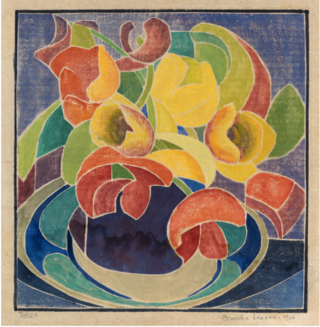
Provincetown Printers were a group of artists, most of them women, who created art using woodblock printing techniques in Provincetown, Massachusetts during the early 20th-century. It was the first group of its kind in the United States, developed in an area when European and American avant-garde artists visited in number after World War I. The "Provincetown Print", a white-line woodcut print, was attributed to this group. Rather than creating separate woodblocks for each color, one block was made and painted. Small groves between the elements of the design created the white line. Because the artists often used soft colors, they sometimes have the appearance of a watercolor painting.
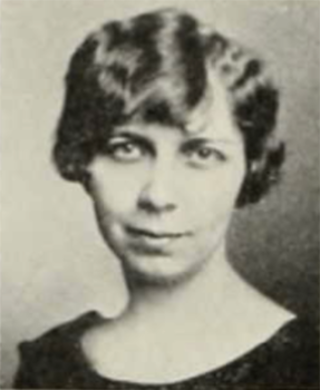
Mabel Hewit (1903–1984) was an American woodblock print artist, particularly the white-line style of the Provincetown Printers.

Charles Turzak was an American artist, known primarily for his modernist woodblock prints, particularly works depicting American historical subjects, including his best-known work Abraham Lincoln: Biography in Woodcuts (1933).
















